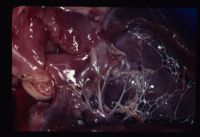Difference between revisions of "Category:Cardiovascular System - Developmental Pathology"
| Line 33: | Line 33: | ||
===[[Vascular Ring Anomaly]]=== | ===[[Vascular Ring Anomaly]]=== | ||
| − | ===Tetralogy of Fallot=== | + | ===[[Tetralogy of Fallot]]=== |
| − | |||
| − | |||
| − | |||
| − | |||
| − | |||
| − | |||
| − | |||
| − | |||
| − | |||
| − | |||
| − | |||
| − | |||
| − | |||
| − | |||
| − | |||
| − | |||
| − | |||
==Valve Development== | ==Valve Development== | ||
Revision as of 15:53, 11 June 2010
Congenital abnormalities occur relatively commonly in young (approximately 1% all human births). May produce dramatic clinical signs or signs may be vague, such as failure to thrive. Clinical signs may become more apparent as the animal grows and activity levels increase.
The aetiology of congenital defects of the heart and great vessels are mostly unknown. Possible contributing factors include:
- Genetic; E.g. Mutation in the ova or sperm or mutation in the zygote.
- Environmental; Includes infection (usually viral), chemical, nutritional and physical factors.
Understanding the normal development of the heart and great vessels allows an understanding of the morphology and pathology of the congenital abnormalities seen in mammals.
Content
Chamber Development
Atrial Septal Defect
Ventricular Septal Defect
Patent Ductus Arteriosus
Great Vessels
Vascular Ring Anomaly
Tetralogy of Fallot
Valve Development
Aortic Stenosis
Obstructs blood flow from the left ventricle to the aorta. Stenosis may be:
- Subvalvular (most common in dog and cat).
- Valvular.
- Supravalvular.
Subvalvular stenosis results in a jet of blood hitting the aortic valve, leading to damage and increased risk of developing endocarditis.
Incidence:
- Increased prevalence in Boxers and Golden retrievers.
- Autosomal dominant in Newfoundlands.
Clinical Signs:
- Vary from asymptomatic to degrees of exercise intolerance, syncope and even sudden death.
- Harsh systolic murmur at left heart base.
Grade correlates with grade of murmur. High grade murmurs also have a precordial thrill.
- Murmur may have a diastolic component due to aortic valve damage and insufficiency.
- Weak femoral pulse.
Diagnosis:
- Left ventricular enlargement on radiology and ECG.
- Post-stenotic dilatation of the aorta may be visible on radiographs.
- Echogenic fibrous ring may be seen on echocardiography. Again, Doppler is useful to detect flow rates.
Treatment:
- Balloon valvuloplasty; often unsuccessful.
- Mild cases need no management.
- Medical management; Beta-blockers to decrease myocardial oxygen consumption.
- Prognosis guarded, death due to arrythmias in abnormal myocardium.
Pulmonic Stenosis
Obstructs blood flowing form the right ventricle to the pulmonary artery. As with aortic stenosis may be subvalvular, valvular or supravalvular. Valvular stenosis is the most common form in the dog.
Incidence:
- Increased incidence in English bulldogs, Cocker spaniels, Chihuahuas.
- Autosomal dominant in Beagles.
Clinical Signs:
- Asymptomatic if mild or moderate.
- If severe; exercise intolerance, stunting, syncope, right sided heart failure E.g. ascites.
- Harsh systolic murmur at left heart base.
- May hear splitting of the second heart sound due to delayed closure of the pulmonic valve.
- Femoral pulse quality good but jugulars distended.
Diagnosis:
- Right ventricular enlargement on radiology, along with post-stenotic dilatation of the pulmonary artery and pulmonary undercirculation.
- Abnormal valve can be imaged using echocardiography.
- Severity of stenosis can be assessed using Doppler to calculate flow rates.
Treatment:
- Balloon valvuloplasty is treatment of choice.
Mitral Dysplasia
Often associated with mitral regurgitation and left atrial volume overload. Usually progresses to left sided heart failure.
Incidence:
- Most common congenital defect in cats.
- Also reported in pure breed dogs E.g GSD, Great Danes.
Clinical Signs:
- Often murmur is the only clinical sign; pansystolic with increased intensity over the mitral valve area.
- May also see exercise intolerance, dyspnoea and coughing.
Diagnosis:
- Left atrial enlargement on radiology and ECG.
- Doppler echocardiography can dtect abnormal flow.
Treatment:
- Prognosis poor, medically manage left heart failure with ACE-inhibitors etc.
Tricuspid Dysplasia
Tricuspid regurgitation results in volume overload of the right atrium and may progress to right heart failure.
Ebstein's Anomaly: Atrioventricular ring is displaced ventrally into the right ventricle so that part of the wall of the right atrium is made up of ventricular wall.
Incidence:
- Second most common congenital anomaly seen in cats.
- Also reported in large breeds of dog including Weimeraner.
Clinical Signs:
- Often the murmur is the only clinical sign; low grade and pansystolic with increased intensity over the tricuspid area.
- May also see right sided failure, signs include; ascites, hepatomegaly and splenomegaly.
Diagnosis:
- Right ventricular enlargement on radiology and ECG.
Miscellaneous
Peritoneo-pericardial Diaphragmatic Hernia
Represents an embryological malformation of the ventral midline with communication to varying degress of the pericardial sac and the peritoneal cavity. Often associated with other malformations for example sternal deformities and ventricular septal defects. Usually results in gastrointestinal or respiratory signs. Visible radiologically as a round cardiac silhouette which merges with the diaphragm. The trachea will be displaced dorsally. Intestines may be visible on radiographs. Repaired surgically.
Ectopia Cordis
The heart is normal in anatomy but situated in an abnormal location within the body. Cattle and pigs show the highest incidence. The heart may be found in the cervical region or the abdomen.
Endocardial fibro-elastosis
Seen in Burmese kittens. Collagen and elastin are deposited in the endocardium, limiting its function. Animals are often found dead at 2-3 months of age.
Pages in category "Cardiovascular System - Developmental Pathology"
The following 14 pages are in this category, out of 14 total.
